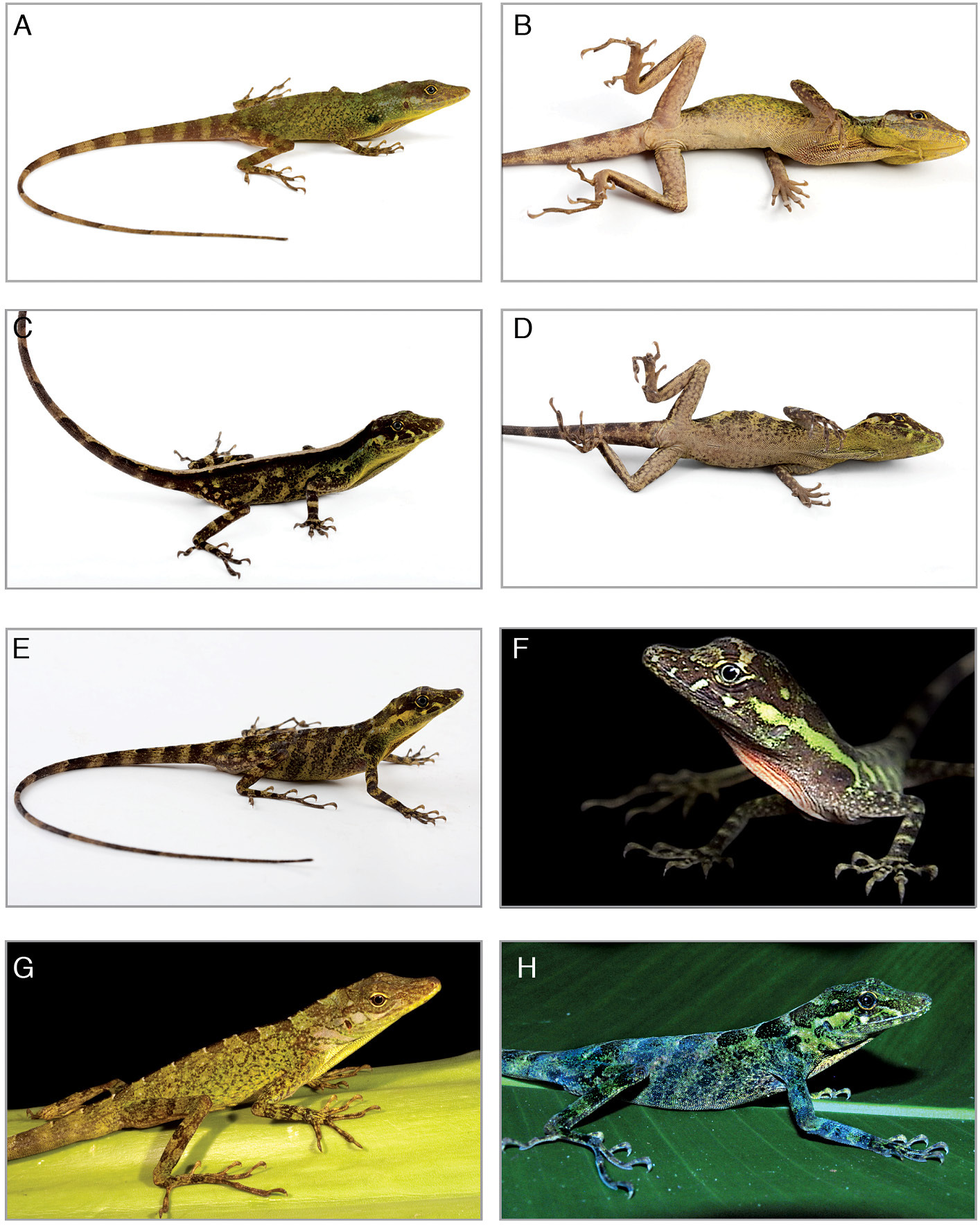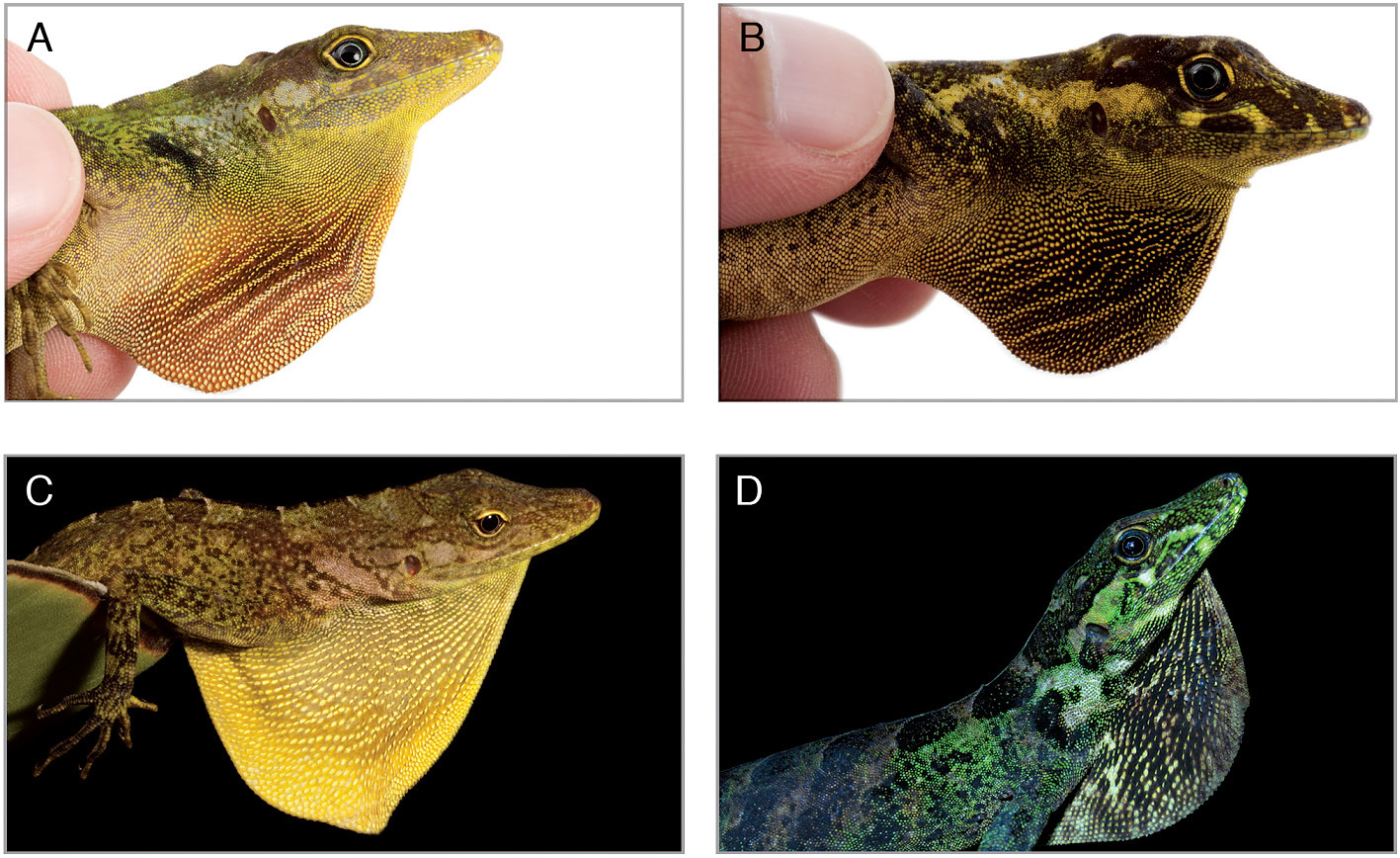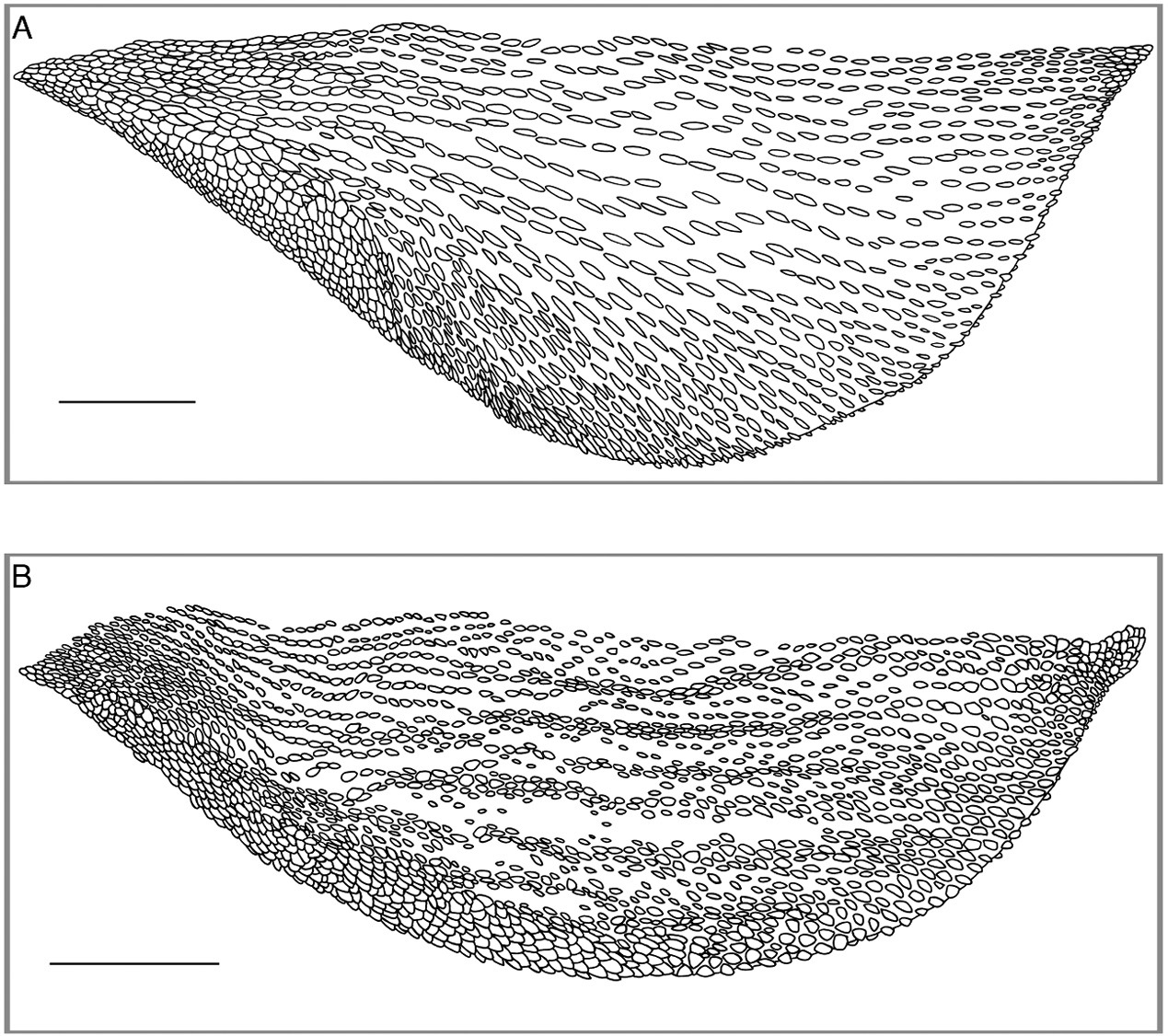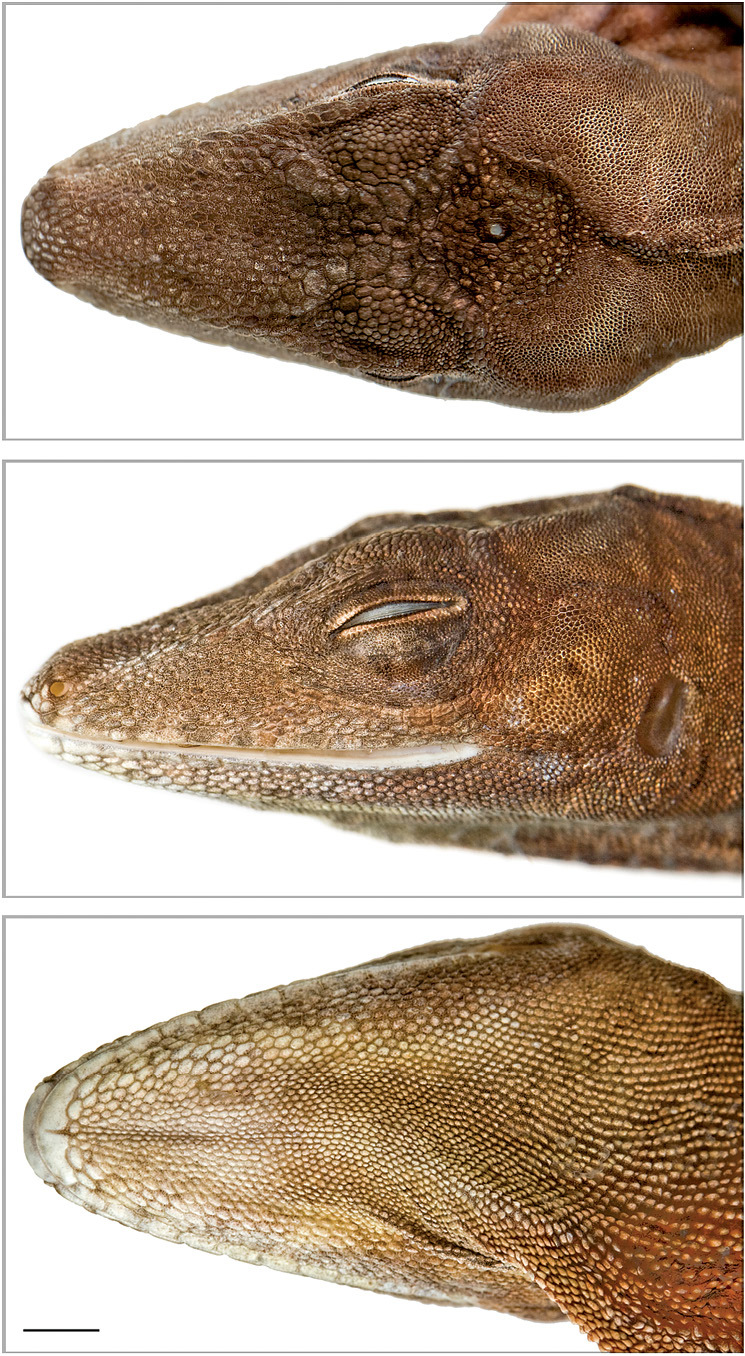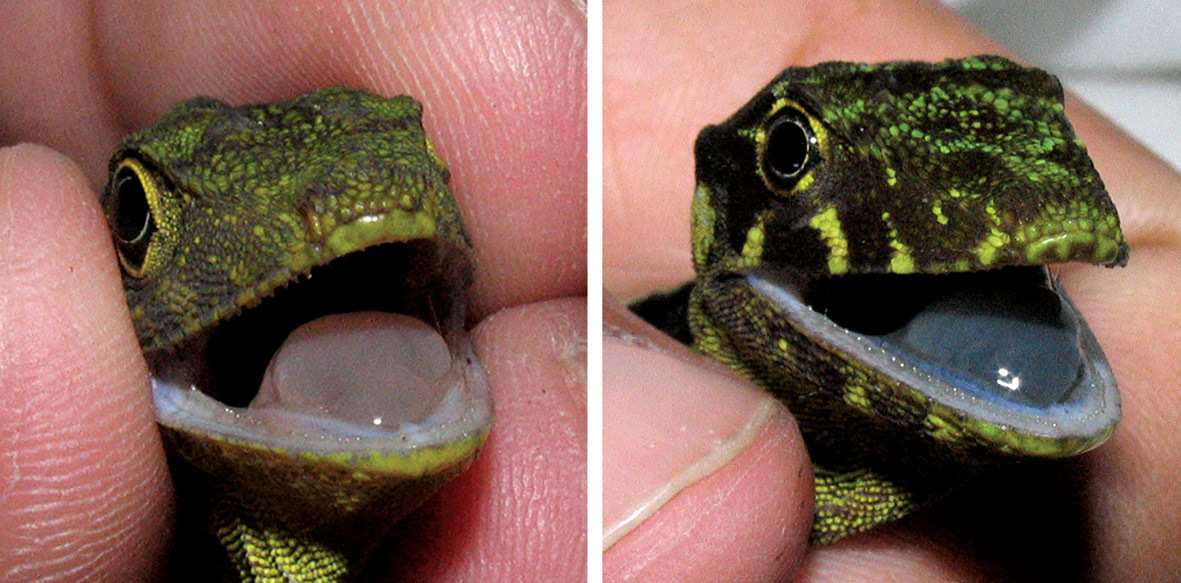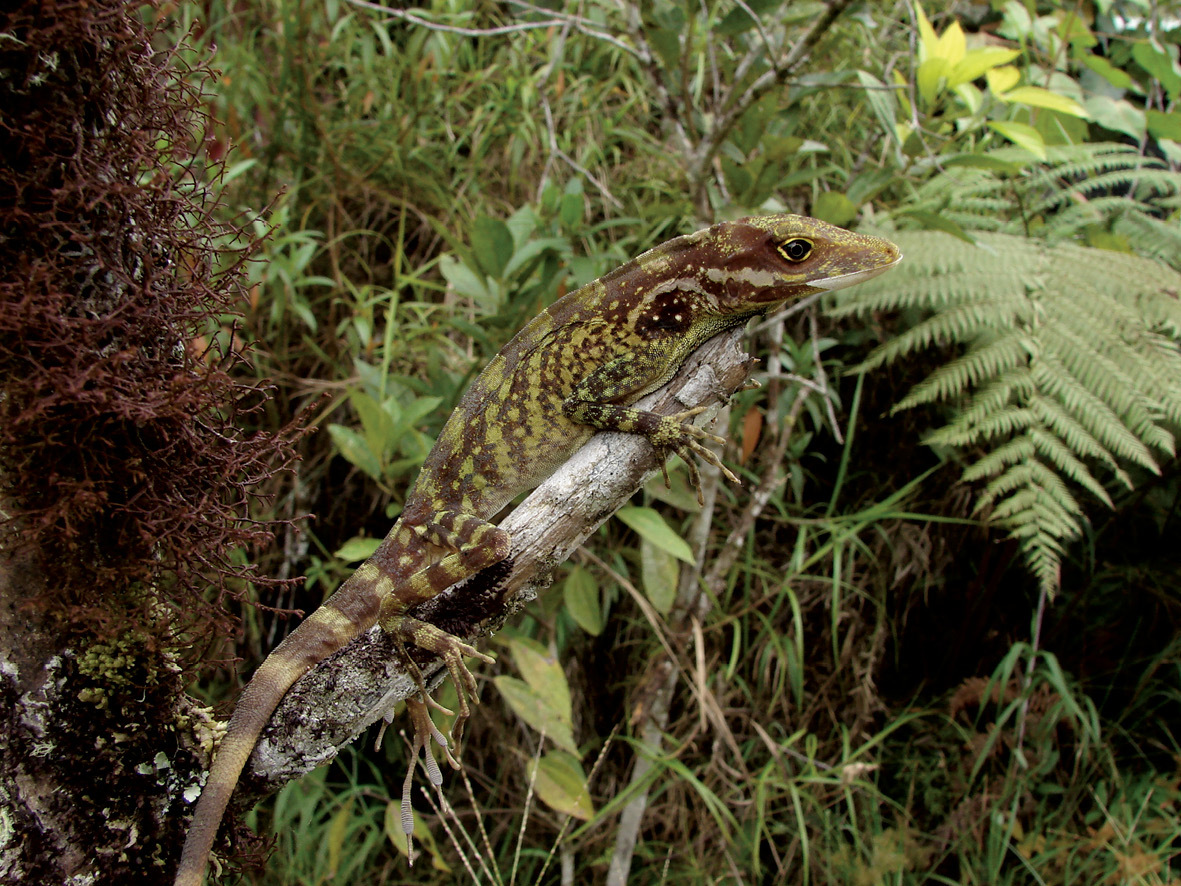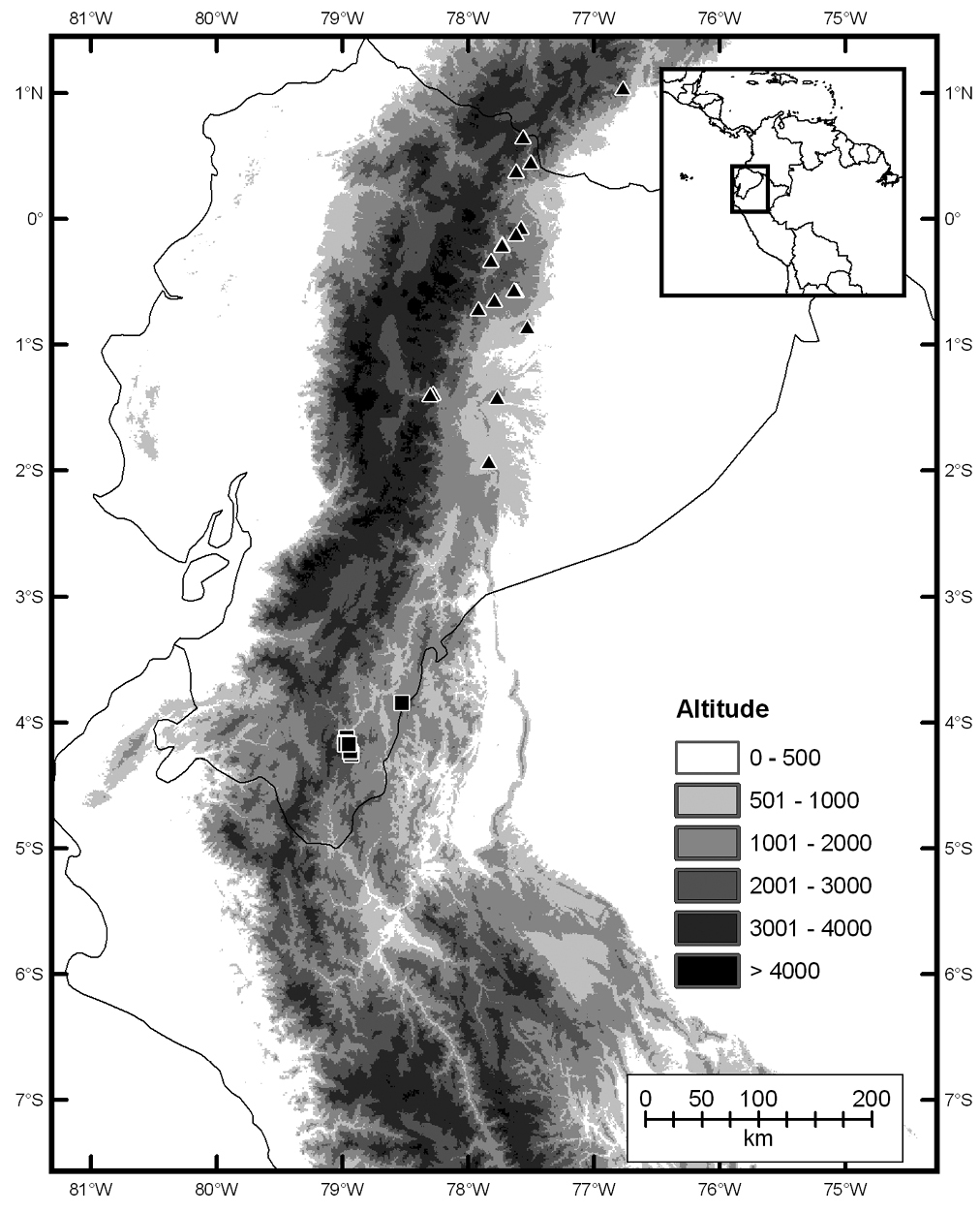(C) 2010 Fernando P. Ayala-Varela. This is an open access article distributed under the terms of the Creative Commons Attribution License, which permits unrestricted use, distribution, and reproduction in any medium, provided the original author and source are credited.
For reference, use of the paginated PDF or printed version of this article is recommended.
We describe a new species of Anolis from the southeastern slopes of the Andes of Ecuador, province of Zamora-Chinchipe, Parque Nacional Podocarpus. It belongs to (1) the aequatorialis species-group by being of moderate to large size with narrow toe lamellae, and (2) the eulaemus sub-group by having a typical Anolis digit, in which the distal lamellae of phalanx II distinctly overlap the proximal scales of phalanx I. The new species is most similar morphologically to Anolis fitchi but differs from it mainly by having a dewlap with longitudinal rows of 2−5 granular, minute scales separated by naked skin (longitudinal rows of one or two keeled, large scales separated by naked skin in Anolis fitchi) and a vertically shorter dewlap (longer dewlap in Anolis fitchi).
Andes, Anolis , Ecuador, new species, Parque Nacional Podocarpus, Polychrotinae , systematics
The lizard genus Anolis (anoles) is the most species-rich genus of amniotes, with nearly 400 described forms (
During revisionary work on anoles of Ecuador, we examined some specimens of Anolis similar to Anolis fitchi Williams and Duellman 1984 collected at the Parque Nacional Podocarpus in southeastern Ecuador. We found that the color pattern of these specimens differed dramatically from typical Anolis fitchi. Detailed examination of these specimens revealed other differences in squamation and color pattern indicative of separate species status.
Materials and methodsSpecimens examined (Appendix and description below) are housed in the herpetological collections of the Escuela Politécnica Nacional, Quito (EPN), Fundación Herpetológica Gustavo-Orcés, Quito (FHGO), Museum of Comparative Zoology, Harvard University (MCZ), Museo Ecuatoriano de Ciencias Naturales, Quito (MECN) and Museo de Zoología, Pontificia Universidad Católica del Ecuador, Quito (QCAZ).
External character terminology follows
All measurements were used in statistical analyses performed in PAST 1.27 (
The distribution map was prepared in ArcMap 9.3 (ESRI, Inc.); WGS84 is the datum for all coordinates presented below.
Resultsurn:lsid:zoobank.org:act:BBCF5322-9297-49D2-B910-ACCC374F9890
QCAZ 10126 (Fig. 1A, B), adult male, Ecuador, Provincia Zamora-Chinchipe, Romerillos Alto, 04°13'35.6"S, 78°56'23.0"W, 1550 m, 18 December 2009, collected by Fernando Ayala, Steven Poe, Levi Gray, and Julian Davis.
Two species of Anolis from eastern Ecuador. Anolis podocarpus sp. n.: holotype male (A, B, QCAZ 10126), female (C, D, QCAZ 10127), female (E, QCAZ 10129), juvenile (F, QCAZ 6200); Anolis fitchi: male (G, QCAZ 8770), female (H, QCAZ 9707). Photographs by L.A. Coloma (male of Anolis fitchi), F. Ayala-Varela (juvenile of Anolis podocarpus sp. n. and female of Anolis fitchi) and S.R. Ron (male and females of Anolis podocarpus sp. n.).
ECUADOR: QCAZ 6038, 6045–47, 6188, QCAZ 6199–200, same locality data as holotype, 1545–1618 m, 1 August 2002, collected by Fernando Ayala-V. and David Salazar; QCAZ 10127, same collection data as holotype; FHGO 1726–30, 1735, 1755, upper basin of Río Curintza, 04°09'36"S, 78°58'48"W, 25 March and 3 April 1998, collected by D. Almeida-Reinoso and F. Nogales-Sornosa; FHGO 2406–07, Numbami, upper basin of río Jambué, 04°10'11.9994"S, 78°57'0"W, 1530 m, 30 April 1999, collected by D. Almeida-Reinoso and F. Nogales-Sornosa; EPN 11354, Campamento San Antonio, Refugio de Vida Silvestre El Zarza, Los Encuentros, cantón Yantzaza, 03°50'27.00"S, 78°31'38.92"W, 1556 m, 07 November 2008, collected by A. Almendáriz, Marco Salazar and Marco Angamarca; EPN 11355, same locality data as former, 14 November 2008, collected by A. Almendáriz, Luis Benalcázar, Marco Angamarca and W. Torres.
The new species belongs to the punctatus-subsection (
Among species in the eulaemus-subgroup (Anolis antioquiae
Among all species in the eulaemus-subgroup Anolis podocarpus is most similar morphologically to Anolis fitchi; in addition to the differences mentioned above, Anolis podocarpus can be distinguished from Anolis fitchi (character states in parentheses, Table 1) by having more scales between second canthals (14–20 and 12–20, respectively; t-test, t = 4.126, P < 0.05); more scales bordering the rostral posteriorly (7–12 and 5–10, respectively; t-test, t = 3.551, P < 0.05); more rows of loreals (9–13 and 6–12, respectively; t-test, t = 7.601, P < 0.05); more postmentals (5–9 and 4–8, respectively; t-test, t = 3.119, P < 0.05); shorter dewlap in males (dewlap height/SVL = 0.10–0.23 and 0.18–0.36, respectively; t-test, t = 4.212, P < 0.05); shorter dewlap in females (dewlap height/SVL = 0.11–0.19 and 0.14–0.23, respectively; t-test, t = 3.165, P < 0.05); and sides of neck with light-blue and pale pink small spots in males (sides of neck with a light yellow irregular stripe, Fig. 1G, H).
| Character | Anolis fitchi | Anolis podocarpus | F-value | P | t-value | P |
|---|---|---|---|---|---|---|
| Scales between second canthals | 12–20 (37) 14.95 ± 1.88 | 14–20 (19) 17.11 ± 1.79 | 1.107 | 0.843 | 4.126 | <0.05 |
| Postrostrals | 5–10 (37) 7.68 ± 1.27 | 7–12 (19) 8.89 ± 1.10 | 1.333 | 0.522 | 3.551 | <0.05 |
| Rows of loreals | 6–12 (37) 8.38 ± 1.23 | 9–13 (19) 10.84 ± 0.96 | 1.655 | 0.255 | 7.601 | <0.05 |
| Scales between supraorbital semicircles | 1–3 (36) 2.28 ± 0.66 | 1–3 (19) 1.79 ± 0.63 | 1.094 | 0.864 | 2.650 | 0.011 |
| Scales between interparietal and semicircles | 3–7 (37) 4.46 ± 0.99 | 2–6 (19) 3.79 ± 1.03 | 1.089 | 0.800 | 2.366 | 0.022 |
| Supralabials | 8–11 (37) 9.05 ± 0.81 | 8–11 (19) 9.26 ± 0.93 | 1.313 | 0.474 | 0.865 | 0.391 |
| Postmentals | 4–8 (37) 6.00 ± 1.00 | 5–9 (19) 6.89 ± 1.05 | 1.099 | 0.782 | 3.119 | <0.05 |
| Lamellae under phalanges II-III of fourth toe | 19–25 (37) 22.19 ± 1.76 | 20–25 (19) 22.42 ± 1.43 | 1.524 | 0.342 | 0.496 | 0.622 |
| Head length/SVL | 0.24–0.28 (30) 0.26 ± 0.01 | 0.26–0.28 (12) 0.27 ± 0.01 | 1.957 | 0.240 | 2.748 | 0.009 |
| Head length/head width | 1.61–1.94 (30) 1.79 ± 0.07 | 1.66–1.86 (12) 1.77 ± 0.07 | 1.009 | 0.953 | 0.784 | 0.438 |
| Head height/head width | 0.75–0.86 (30) 0.81 ± 0.03 | 0.76–0.87 (12) 0.81 ± 0.03 | 1.097 | 0.796 | 0.379 | 0.706 |
| Forelimb length/SVL | 0.50–0.57 (30) 0.54 ± 0.02 | 0.47–0.61 (12) 0.52 ± 0.04 | 4.355 | <0.05 | 1.510 | 0.155 |
| Hindlimb length/SVL | 0.87–1.02 (30) 0.94 ± 0.04 | 0.82–1.00 (12) 0.90 ± 0.06 | 2.168 | 0.094 | 2.411 | 0.021 |
| Tail length/SVL | 1.84–2.57 (15) 2.33 ± 0.20 | 1.83–2.48 (10) 2.29 ± 0.19 | 1.101 | 0.912 | 0.563 | 0.579 |
| Dewlap height/SVL in males | 0.18–0.36 (17) 0.27 ± 0.06 | 0.10–0.23 (5) 0.16 ± 0.05 | 1.340 | 0.851 | 4.212 | <0.05 |
| Dewlap height/SVL in females | 0.14–0.23 (13) 0.19 ± 0.03 | 0.11–0.19 (7) 0.14 ± 0.04 | 1.500 | 0.517 | 3.165 | <0.05 |
| Maximum SVL males | 96 | 96 | ||||
| Maximum SVL females | 87 | 89 |
Dewlap of Anolis podocarpus sp. n.(A, holotype male, QCAZ 10126; B, female, QCAZ 10129) and Anolis fitchi (C, male, QCAZ 8770; D, female, QCAZ 9707). Photographs by L.A. Coloma (male of Anolis fitchi), F. Ayala-Varela (female of Anolis fitchi) and S.R. Ron (male and female of Anolis podocarpus sp. n.).
Male dewlap of Anolis fitchi (A, QCAZ 9028) and Anolis podocarpus sp. n. (B, QCAZ 10126) in lateral view. Scale bar = 5 mm. Illustrations by D. Paucar-Guerrero.
(variation in paratypes in parentheses). Male (Fig. 4);SVL 87.0 mm (73.6−96.0 mm); tail length 192.0 mm (168.0−224.0 mm); head length 23.3 mm (19.3−25.4 mm); head width 13.0 mm (11.5−13.8 mm); head height 11.0 mm (9.0−12.0 mm); forelimb length 44.9 mm (39.3−49.9 mm); hindlimb length 75.4 mm (70.0−83.9 mm); dewlap height 12.4 mm (8.2−20.2 mm); interparietal length 1.1 mm (0.9−2.0 mm); ear opening maximum length 2.72 mm (2.3−2.9 mm); snout length 9.81 mm (8.6−11.6 mm).
Head scales unicarinate (smooth or rugose); 19 (14−20) scales between second canthals; 17 (16−20) scales between first canthals; 10 (7−12) scales bordering the rostral posteriorly; circumnasal separated from rostral by one scale or in contact (anterior nasal or divided anterior nasal in contact with rostral); supraorbital semicircles separated by two (1−3) scales; supraocular disk not differentiated and keeled; one (1–2) short superciliary followed by granules; 12 (9−13) loreal rows; 113 loreal scales (81–135); interparietal smaller (much smaller or similar) than ear opening; 3−5 (2−6) scales between interparietal and semicircles on each side; scales behind interparietal grading into nape scales; suboculars and supralabials separated (in contact) by one scale; 10 (8−11) supralabials counted up to a point below center of eye; 9 (9−11) infralabials counted up to a point below center of eye; six (5−9) postmentals; enlarged sublabials absent (one enlarged sublabial in contact with infralabials).
Dorsal crest absent; two enlarged middorsal rows (enlarged middorsal rows absent); dorsals swollen, unicarinate or conical; flank scales more or less separated by skin (juxtaposed); ventrals equal than dorsals (ventrals larger than dorsals); ventrals slightly protuberant, smooth, and subimbricate (separated from each other by skin or juxtaposed).
Toepads overlap the first phalanx in all toes; 20 (20−25) lamellae under second and third phalanges of fourth toe; supradigitals multicarinate; tail weakly compressed; postanals absent (present or inconspicuous).
Nuchal and dorsal folds weakly developed (folds absent in females); dewlap large in both sexes extending posteriorly behind forelimbs, with longitudinal rows of 3−4 (2−5) granular, minute scales separated by naked skin.
Sexual variation of meristic and morphometric characters in Anolis podocarpus is presented in Table 2.
Head of the holotype (QCAZ 10126) of Anolis podocarpus sp. n. in dorsal (top), lateral (middle), and ventral (bottom) views. Photographs by L. Bustamante. Scale bar = 10 mm.
| Character | Males | Females |
|---|---|---|
| Scales between second canthals | 16–20 (6) 17.33 ± 1.75 | 14–20 (13) 17.00 ± 1.87 |
| Postrostrals | 7–10 (6) 8.50 ± 1.22 | 8–12 (13) 9.08 ± 1.04 |
| Rows of loreals | 9–12 (6) 10.83 ± 0.98 | 9–13 (13) 10.85 ± 0.99 |
| Scales between supraorbital semicircles | 1–2 (6) 1.67 ± 0.52 | 1–3 (13) 1.85 ± 0.69 |
| Scales between interparietal and semicircles | 2–6 (6) 3.67 ± 1.51 | 3–5 (13) 3.85 ± 0.80 |
| Supralabials | 8–11 (6) 9.33 ± 1.21 | 8–11 (13) 9.23 ± 0.83 |
| Postmentals | 5–8 (6) 6.50 ± 1.05 | 6–9 (13) 7.08 ± 1.04 |
| Lamellae under phalanges II-III of fourth toe | 20–24 (6) 22.17 ± 1.33 | 21–25 (13) 22.54 ± 1.51 |
| Head length/Snout-vent length | 0.26–0.28 (5) 0.27 ± 0.01 | 0.26–0.27 (7) 0.26 ± 0.01 |
| Head length/head width | 1.77–1.86 (5) 1.81 ± 0.03 | 1.66–1.83 (7) 1.73 ± 0.07 |
| Head height/head width | 0.81–0.87 (5) 0.83 ± 0.02 | 0.76–0.83 (7) 0.79 ± 0.03 |
| Forelimb length/snout-vent length | 0.49–0.58 (5) 0.52 ± 0.04 | 0.47–0.61 (7) 0.52 ± 0.05 |
| Hindlimb length/Snout-vent length | 0.85–0.98 (5) 0.89 ± 0.05 | 0.82–1.00 (7) 0.91 ± 0.06 |
| Tail length/Snout-vent length | 1.83–2.48 (5) 2.26 ± 0.26 | 2.19–2.45 (5) 2.32 ± 0.11 |
| Dewlap height/Snout-vent length | 0.10–0.23 (5) 0.16 ± 0.05 | 0.11–0.19 (7) 0.14 ± 0.04 |
| Maximum SVL | 96 | 89 |
(Fig. 1A, B). Head, body and limbs green; head with two dark green transverse bands on the supraocular disk separated by one yellowish green transverse band; body with a vertebral series of wide, dark brown blotches that diffuse without reaching flanks; limbs and tail with wide, dark brown transverse bands; side of neck with an aquamarine irregular longitudinal stripe that extends from postocular region above the tympanum to level of shoulder; side of shoulder with a greenish black irregular spot and opaque pink dots; body flanks with small turquoise dots; ventral surface of head pale yellow, with two pairs of lateral, yellow, short bands; ventral surface of body yellowish cream; ventral surface of tail cream anteriorly, with reddish-brown transverse bands posteriorly; ventral surface of hindlimbs pinkish cream with reddish brown reticulations; dewlap skin terracotta with dark brown tint anteriorly and orange tint posteriorly; dewlap scales yellow anteriorly, and white-yellow posteriorly; upper and lower palpebrals yellow; iris bluish-turquoise with white ring; tongue pink (Fig. 5).
Tongue of Anolis podocarpus sp. n. Left: holotype adult male (QCAZ 10126); right: adult female (QCAZ 10127). Photographs by F. Ayala-Varela.
Head, body and limbs brown; head with a light brown transverse band on the supraocular disk; body flanks brown with dark green small reticulations; limbs and tail brown, with wide, dark brown transverse bands; side of neck brown with cream dots; side of shoulder with a black irregular spot and cream dots; ventral surface of head brownish cream; ventral surface of body brownish cream with brown dots; ventral surface of tail cream anteriorly and brown posteriorly; ventral surface of hindlimbs cream with brown reticulations; dewlap skin dark brown; dewlap scales brownish cream with white scales posteriorly; upper and lower palpebrals brownish cream.
Adult male QCAZ 6038: Head and limbs yellowish green, body green, and tail creamish green; body with a series of seven vertebral wide, yellowish brown bands that diffuse without reaching flanks; sides of head with a light blue irregular stripe extending from postocular region to level of the shoulder; sides of neck with pale pink dots; sides of shoulder with a blackish brown spot and pale pink dots; body flanks green with dark green and turquoise dots, and with dark greenish brown spots assembling alternating bands extending posteroventrally; ventral surface of head greenish yellow anteriorly and pale yellow posteriorly, with two pairs of lateral, yellow, short bands; ventral surface of hindlimbs cream with pale brown reticulations; dewlap skin reddish brown with dark brown tint anteriorly and pink tint posteriorly; dewlap scales greenish yellow anteriorly, and white posteriorly.
Adult male EPN 11355 (Fig. 6) differs from the descriptions above in having a cream irregular stripe that extends from the angle of the jaw above the tympanum to the neck; side of neck with a cream irregular stripe that forms an arc extending from the proximal border of the dewlap to the shoulder; shoulder with a greenish black irregular spot and pink dots.
Adult female QCAZ 10127 (Fig. 1C, D): Head lime-green with two blackish brown transverse bands on supraocular disk; body and tail blackish brown with a whitish-cream vertebral stripe; limbs yellowish green with wide, blackish-brown transverse bands; two subocular pale yellow stripes extending anterodorsally (posteriormost stripe) and posterodorsally (anteriormost stripe) from supralabials; lateral aspect of neck with a longitudinal aquamarine stripe that extends posteriorly from the posterior end of the eye over the tympanum to the level of the forelimb; body flanks yellowish green with dark brown spots that cluster anteriorly, posteriorly, and at midbody; ventral surface of head greenish cream with two pairs of lateral, pale yellow, short bands; ventral surface of body brownish cream with blackish brown spots; ventral surface of limbs brownish cream, with blackish brown reticulations; ventral surface of tail brownish cream on the base, with blackish brown transverse bands; dewlap skin dark violet with a brownish-red tint; dewlap scales yellow; iris bluish-turquoise; tongue dark blue (Fig. 5). Adult female QCAZ 10129 (Fig. 1E) differs from the previous description in having a longitudinal series of five wide, dark brown transverse bands that extend posteroventrally over flanks.
Juvenile QCAZ 6200 (Fig. 1F): Color pattern is similar to adult female QCAZ 10129, but differs in having dewlap skin orange-red with white scales and tongue orange.
Male of Anolis podocarpus sp. n. (EPN 11355) from El Zarza (Zamora Chinchipe province). Photograph by A. Almendáriz.
An adult female (SVL 89.1 mm, QCAZ 6045) collected on 1 August 2002 and held in captivity until 27 September 2002 laid an egg (18.5 x 8.4 mm; 682.1 mm3) on 24 August 2002. A juvenile (FHGO 1730) was collected on 25 March 1998 (37.0 mm SVL, 82.5 mm tail length); a larger juvenile (QCAZ 6200) was collected on 1 August 2002 (43.5 mm SVL, 96.0 mm tail length).
Specimens of Anolis podocarpus were collected in secondary forest near small streams or in ravines. All individuals were found between 19:00 and 23:00 h sleeping head-up on leaves of ferns, Araceae, Musaceae, on branches 0.30–2.50 m above streams, or on stream shores. This species occurs in sympatry with two undescribed species of anoles at the type locality.
Anolis podocarpus
inhabits the eastern slopes of the eastern Andean cordillera in
southern Ecuador, Zamora-Chinchipe province, between 1530−1910 m (Fig. 7).
It is known from the upper basin of the Zamora river (Atlantic
drainage) in montane cloud forest and low montane evergreen forest (
Distribution of Anolis fitchi (triangles) and Anolis podocarpus sp. n. (squares).
The specific epithet podocarpus alludes to the conifer Podocarpus and derives from the Greek words pous, podos (=foot), and karpos (=fruit). The tree Podocarpus gives its name to Parque Nacional Podocarpus, where the new species described in this paper was discovered.
We thank Ana Almendáriz (EPN), María Elena Barragán (FHGO), Luis A. Coloma (QCAZ), James Hanken (MCZ) and Miguel Moreno (MECN) for loans of museum specimens. Fernando Ayala-Varela thanks Steven Poe, Julian Davis, Levi Gray and David Salazar-Valenzuela for help in the field. We also thank Diego Paucar-Guerrero for the illustration of the dewlaps; Luis Coloma, Santiago Ron, Ana Almendáriz and Lucas Bustamante for the photos; Paulina Santiana for help in the edition of pictures; Amaranta Carvajal-Campos for the map; Pablo Menéndez-Guerrero and Teresa Ayala-Varela for comments. FAV is especially grateful to the Nogales-Sornosa family for their hospitality in Loja and Diego Almeida-Reinoso who provided ecological information. This work was partially funded by Secretaría Nacional de Ciencia y Tecnología del Ecuador (SENACYT), project PIC-08-0000470. Specimens were collected under collection permits 001-IC-FAU/FLO/DRZCHI/MA and 008-09 IC-FAU-DNB/MA issued by Ministerio del Ambiente.
Anolis fitchi – Ecuador: Morona-Santiago: “Chiquara” (sic Chiguaza), 01°55'60S; 77°49'60W, MCZ 124355–56; Cordillera del Cutucú, Comunidad Uuntzuanz, 1250–1300 m, EcoC 1348; Napo: Cordillera de los Guacamayos, 2200 m, QCAZ 3112, 3173; El Chaco, 1400 m, QCAZ 3092; Galeras, QCAZ 3758; Parque Nacional Sumaco Napo-Galeras, Cocodrilos, 00°38'57S; 77°47'35W, 1846 m, QCAZ 5439–42; Volcán Sumaco, vertiente Este, 1570–1642 m, QCAZ 920, 926; 30 km N of turnoff to Baeza, 00°17'31.7394S; 77°46'30.6582W 1661 m, QCAZ 9707; Orellana: Alto Napo, Loreto, MCZ 124351; Cabecera del río Sola, MCZ 124352; Región de Loreto, MCZ 124350; Pastaza: “Río Villaro” (sic Río Villano), 01°25'11.9994S; 77°46'11.9994W, MCZ 124353–54; Sucumbíos: El Reventador, Gonzalo Pizarro, EPN 7056–57; El Reventador, Recinto La Libertad, La Virgen, 00°4.29'1S; 77°34.8'1W, 1679 m, QCAZ 5997, 8770; La Bonita, 1500–1590 m, FHGO 446, EPN 3158; La Sofía, 00°22'40N; 77°38'02W, 1648–1800 m, EPN 7583–93; Río Azuela, 1700 m, QCAZ 5425, 5435–38, 5502–03; Santa Bárbara, Sebundoy, 2200 m, EPN 3159; Tungurahua: Parque Nacional Los Llanganates, El Topo, 01°23'08S; 78°16'49W, 2150 m, MECN 35; Río Verde, 01°24'16S; 78°17'48.3W, 1512 m, QCAZ 5648–49, 5715.







